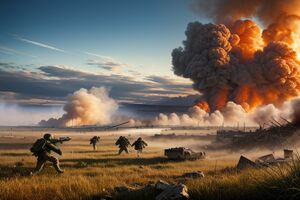Rise of Orderism in Nestor
 Image description: Battle of Veclar | |
| Important engagements: | Battle of Veclar, Battle of Tunir |
|---|---|
| Date: | 7677 – 7687 |
| Location: | Nestor, Stelneck island |
| Result: | Nestorian victory |
| Resulting treaties: | Treaty of Tunir |
| Belligerents | |
| Nh-version1.2.2.png | PH NOR.png |
| Commanders and leaders | |
| Strength | |
| 282.000 Infantry, 4.147.530 Militia | 98.000 Infantry |
| Casualties | |
| Military Casualties 11.000 dead, 2.100 missing (T.B.C.) | Military Casualties 31.000 dead, 9.200 missing (T.B.C.) |
| Civilian casualties: 11.514 Civilian casualties (T.B.C.) | Civilian casualties: 941 Civilian casualties(T.B.C.) |
Nestorian Conflict: Rise of Orderism and Rebellion (7677-7687)
The Nestorian Conflict, a pivotal chapter in the history of Nestor, unfolded as Nestor, a conservative and militaristic island nation, faced internal turmoil amid growing influence from the Stolvic Orderist Commonwealth. This conflict, spanning from 7676 to 7687, marked a significant departure from Nestor's historically stable trajectory.
Background
Nestor's isolationist tendencies persisted until the aftermath of the first Wolgos War (7598-7603), which prompted the nation to open up to the outside world. Progressive ideas from the Stolvic Orderist Commonwealth gained traction among the Nestorian populace, leading to calls for reforms that clashed with the government's staunch resistance.
Events
7676: Stelneck Protest and Divide
In 7676, the island of Stelneck closest to the Stolvic Orderist Commonwealth witnessed a large protest organized by locals. The government's heavy-handed response, resulting in 41 casualties, intensified the divide between pro-conservatives supporting the harsh action and pro-progressives condemning it as inhumane.
7678: Unrest in the North-West
The north-western region, particularly Stelneck and Tricor, experienced increased instability. The government deployed additional soldiers, triggering the emergence of two opposing factions—the peaceful Nestorian Orderist Party (NOP) advocating for progressive laws and the radical Nestorian Orderist Rebellion (NOR). The SOC supported the NOR to destabilize Nestor and promote Orderism.
7679-7681: Escalation and Rebellion
The NOR escalated its activities, the government painting them as terrorists. Shootouts ensued, resulting in casualties on both sides. NOR members covertly moved to Stelneck, seizing control of militia and military bases. With over 100 thousand members, the NOR's true strength remained elusive.
7682: Island Independence and Intervention
The NOR on Stelneck declared independence and aligned with the SOC. The Nestorian government, facing military intervention, was blocked by the SOC, claiming the island as their own. International pressure, particularly from capitalist nations, forced the SOC to lift the blockade. A ground offensive against the NOR commenced, preventing an all-out war.
7687: Aftermath and Tensions
Following the conflict, rebels either sought refuge in the SOC or went underground in Stelneck and Nestorian mainland. The Nestorian government, complying with the SOC treaty, handed control of the island to Veclar, a Nestorian militia group. While tensions eased, the SOC remained discontent with Nestor's treatment of Orderist rebels.
7688-7690: Modern NOR
The NOR has not been fully defeated, the NOR still aims to destabilise and sieze control over the entire nation. They have two goals, make the Nestorian people scared with suicide bombing and to gain more members than they lose. It is unknown how many NOR members there are but estimates has put the number to be in between 10.000 to 220.000 members in total. The Nestorian militia and national military have stated to decrease the threat of the NOR. The attacks after the official defeat has so costed 5344 death.